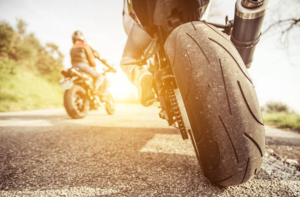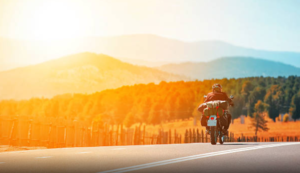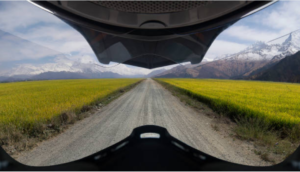When many of us think of reasons why someone would get a motorcycle, dreamy thoughts of freedom and rebelliousness often spring to mind.
While there’s no discounting that type of motivation, I think you’ll agree with me when I say that motorcycle ownership has so much more to it. In fact, there are many practical reasons for getting a motorcycle, from their incredible fuel efficiency and affordability to easier parking and commuting.
When it comes to the practicality of motorcycles, though, safety takes first priority. Do you know what the number one reason people are told not to ride a motorcycle?
You guessed it…it involves safety–or danger, to be more precise.
The truth is, though, all vehicles involve an element of danger. The important part is taking control of your safety when you ride.
Let me walk you through 10 steps to minimize the risk of riding that beautiful bike so you can experience all the benefits that you were interested in when you bought it.
1. Get the right bike for you
The first thing you want to be sure of is that you have the right motorcycle for you.
Now, this is important…
It involves a few things, and we’re not just talking price range. When buying a motorcycle, you need to be honest with yourself. How skilled are you as a rider? Can you handle a larger or more powerful bike? That might be a hard truth to face as a newer rider, but you can always upgrade as you gain experience.
The second part of this question is how you intend to use your motorcycle. Are you planning on long road trips, short commutes, or something in between? This will affect what type of motorcycle you want. Having the right bike for you will help make you a safer rider.
2.Practice
No matter how skilled you are as a rider, there’s always room to get better.
Riding a motorcycle is like so many other things. It is a skill, and skills can be improved. To be safe on your bike, you should take riding courses when you are new.
Then you should practice — and when you are finished, you should practice some more. You can always get better. You can also learn different tips and techniques from different instructors, so taking multiple riding courses and keeping at it over time will really help keep you safe.
3. Keep Your Head
This might be a controversial topic in some circles, but the fact is, helmets save lives.
States like Michigan that repealed helmet laws have later seen significant increases in motorcycle-related fatalities. Though the thought of having the air flow through your hair as you ride might sound romantic, staying alive is much more appealing.
And on top of that, there’s the additional bonus of keeping the bugs out of your teeth if you wear a motorcycle helmet with a face guard.
4. Protect the Essentials
In addition to a helmet, wearing the right protective gear is a must for staying safe on your bike.
Personal protective equipment is a cornerstone of rider safety. Wearing the right riding gear can significantly reduce the likelihood of injury or risk of death in the event of a motorcycle crash.
If you have seen someone riding in flip flops, shorts and a t-shirt, you know what we mean. Imagine if that rider had to bail and skid across the blacktop.
Protecting yourself with heavy clothing and gear that covers your skin is like wearing a coat of armor. As another plus, you instantly make it easier for your friends and family to shop for you. Here’s what you need:
- A DOT-compliant helmet that meets U.S. Department of Transportation Federal Motor Vehicle Safety Standard (FMVSS) 218. This is non-negotiable for protecting your head.
- Leather or heavy denim pants and jacket to protect against road rash and abrasions.
- Boots or shoes that cover your ankles to prevent foot and ankle injuries.
- Gloves to protect your hands. Find a good pair and have an extra in your essentials tool kit if you’re planning a trip.
- Eye protection, such as goggles or a face shield, to shield your eyes from wind, dust, and debris.
Remember, wearing protective gear is not just about protecting yourself; it’s also about setting an example for other riders and promoting a culture of safe riding on the roads. By gearing up properly, you’re taking a significant step towards ensuring your safety and encouraging others to do the same.
5. Gear Up Your Bike
Your motorcycle needs the right gear, too.
More specifically, anti-lock brakes will go a long way toward making your riding experience safer. The stopping power is vital in a world in which people don’t always see motorcycles. Having that extra protection makes a big difference for so many riders.
6. Expect the Worst
Let me elaborate. While we are on the topic of other drivers, it is best to always be in a defensive mindset.
Drivers make mistakes. They can also get nervous or absent-minded around motorcycles. If you remain on guard and anticipate the ways in which other drivers can put you at risk, you will be more likely to avoid dangerous scenarios. You can also be pleasantly surprised when they don’t try to run you over.
7. Mind Your Mother
Mother nature, that is…
Before you head out for a ride, check the weather conditions. If bad weather is on the horizon, it would be best to wait it out and find other means of transportation.
8. The Pre-Ride Checklist
Before every ride, it’s crucial to perform a pre-ride checklist to ensure your motorcycle is in top-notch condition. Here’s what you need to do:
- See if there are any cracks, bulges, or signs of excessive wear on your tires
- Check tire pressure and tread depth to ensure they are within safe limits.
- Inspect both hand and foot brakes to make sure they are functioning properly.
- Test your headlights, taillights, and signal indicators to ensure they are working.
- Check all fluid levels, including oil, brake fluid, and coolant.
- Look for any signs of oil or gas leaks that could indicate a problem.
- Secure and balance any cargo to avoid instability while riding.
- Adjust suspension and tire pressure as needed based on your load and riding conditions.
- When you get on, check the mirrors and honk the horn too to check if it works
These simple checks will only take a couple minutes, and they can help you avoid serious problems on the road. These are key to keeping you safe so always inspect your motorcycle before going for a ride.
9. Eyes on the Road
Speaking of the road, make sure you are always mindful of what’s up ahead. Watch the road for unsafe conditions like cracking surfaces or blind curves. Approach potential obstacles carefully. This type of mindset is especially important on long rides in the country. Rural roads might be less well maintained. Plus, we can get lulled into a less attentive mindset on longer rides.
It is also crucial for you to be mindful of other vehicles on the road. Be sure to keep at safe breaking distance from other vehicles. Make sure to always check blind spots before making turns or changing lanes. And always, obey speed limits and traffic laws at all times as a general rule to avoid motorcycle accidents.
10. Wake Up
This tip should go without saying, but that doesn’t mean it shouldn’t be said.
Never ride your bike under the influence of alcohol or when excessively tired. Doing so would put you and those around you in danger.
Riding a motorcycle unleashes a rush of positive forces inside us. From the feeling of freedom that comes from soaring across the landscape to really feeling the road beneath, riding a motorcycle is therapy on wheels. A bike will also save you money on gas and show your mother earth that you care. Take care of yourself while you are at it and enjoy many more rides to come.
We treat every customer with the care and attention they deserve. Contact Southeast Financial today to find out how we can help you get one step closer to the road with the motorcycle of your dreams.




